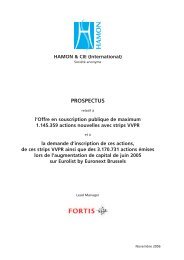Download PDF version English(2664KB) - Hamon
Download PDF version English(2664KB) - Hamon
Download PDF version English(2664KB) - Hamon
Create successful ePaper yourself
Turn your PDF publications into a flip-book with our unique Google optimized e-Paper software.
98<br />
<strong>Hamon</strong> Annual Report 2010<br />
Forward currency contracts used to hedge the transactional<br />
risks on currencies are accounted as if they were held<br />
for trading.<br />
However, such forward currency contracts are only used<br />
to hedge existing transactions and commitments and are<br />
therefore not speculative by nature.<br />
The fair values were directly recognized in the income<br />
statement in unrealized exchange gains or losses.<br />
37. FINANCIAL INSTRUMENTS<br />
Financial Assets and Liabilities<br />
in EUR ‘000’ 31/12/10 31/12/09 31/12/08 Hierarchy of<br />
fair values<br />
Financial Assets<br />
Cash and cash equivalents 68 077 83 253 59 089 Niveau 1<br />
Available-for-sale financial assets 6 632 2 421 1 627 Niveau 2<br />
Loans and receivables 97 632 83 681 102 888 Niveau 2<br />
Derivative financial assets 16 230 14 309 62 886 Niveau 1<br />
188 571 183 664 226 490<br />
Financial Liabilities<br />
Borrowings at amortized cost 80 953 75 065 69 858 Niveau 1<br />
Other payables 66 551 56 569 58 181 Niveau 2<br />
Derivative financial liabilities 16 101 13 924 64 049 Niveau 1<br />
163 605 145 558 192 088<br />
Fair value and book value<br />
In order to show the importance of data’s used for the<br />
valuations of fair values, the Group classifies these<br />
valuations according to a hierarchy that includes the<br />
following levels:<br />
■ Level 1 fair value measurements are those derived<br />
from quoted prices (unadjusted) in active markets for<br />
identical assets or liabilities;<br />
■ Level 2 fair value measurements are those derived<br />
from inputs other than quoted prices included within<br />
Level 1 that are observable for the asset or liability,<br />
either directly (i.e. as prices) or indirectly (i.e. derived<br />
from prices); and<br />
■ Level 3 fair value measurements are those derived<br />
from valuation techniques that include inputs for the<br />
asset or liability that are not based on observable<br />
market data (unobservable inputs).<br />
Financial assets are mostly current. Their fair value thus<br />
does not differ from their book value. Their book value<br />
already takes into account possible provisions when the<br />
collection seems compromised. Available-for-sale<br />
financial assets are made on the one hand, of our share<br />
in GEI, valued at stock market price on 31 December,<br />
and on the other hand of investments in various small<br />
companies not quoted on the stock market and valued<br />
at their acquisition value. Their fair value is higher than<br />
their acquisition value but given the fact that the impact<br />
is minimal, no correction has been accounted for.<br />
Non-current financial liabilities were evaluated at<br />
amortized cost; which is net of transaction costs.<br />
Borrowings principally include the syndicated debt for<br />
which the fair value is comparable to the value in the<br />
accounts. “Other payables” are mainly trade payables<br />
for which the fair value does not differ from the book<br />
value due to its current nature.<br />
Financial instruments indicated in the table include<br />
Interest Rate Swaps (IRS) in 2008, and forward currency<br />
contracts. These last ones are included in this note on<br />
the asset and liability sides for their notional amount<br />
corrected by their fair value at the asset and liability<br />
side depending whether they are positive or negative.














